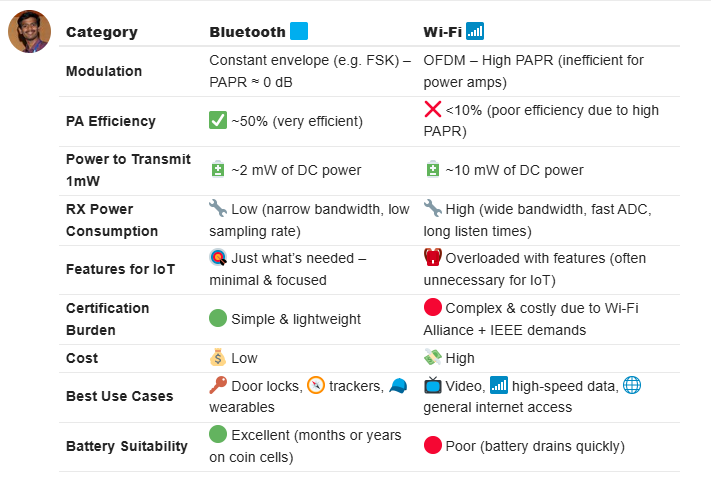Why is Bluetooth more common than Wi-Fi in battery-powered IoT devices? The answer is high cost and high power consumption of Wi-Fi. But why is that?
Despite Wi-Fi having many advantages over Bluetooth such as higher range, significantly higher throughput, WPA3 security, and being IP addressable, Bluetooth still prevails in certain use cases. The primary reason for higher power consumption in Wi-Fi is because of the OFDM-based PHY layer, which has a high peak to average power ratio (PAPR). This leads to operating the power amplifier ¶ very inefficiently, with the PA efficiency during Wi-Fi transmission being less than 10% whereas Bluetooth PA efficiency is 50%. To transmit 1 mW Wi-Fi frame, we need to spend 10 mW of DC power, whereas to transmit 1mW Bluetooth frame, we burn only 2 mW DC power.
Especially, consider the fact that after Wi-Fi 6 the number of OFDM subcarriers have quadrupled (256 subcarriers in 20 MHz bandwidth). Bluetooth on the other hand uses constant envelope modulation scheme ( papr=0 db) such as FSK. LORA, Zigbee and 802.11ad are few other standards using constant envelope modulation schemes.
If only Wi-Fi had defined a constant envelope modulation PHY, the game may have been different in IoT. Another major issue is cost, and in my opinion, that is because of unnecessary baggage of features being required by IEEE and Wi-Fi alliance for certification purposes. Several Wi-Fi features are not really needed for battery powered IOT devices such as wireless door lock for example.
Finally, the RX power consumption of Wi-Fi is higher owing to higher RX bandwidth, higher ADC sampling rate, and uncertainty in listen state duration owing to no guarantee service periods during power save operation.
While Target Wake Time (TWT) made an attempt, it wasn’t really successful because TWT service periods are not reserved, and any client can barge into another client’s TWT service period for sending its uplink traffic.
Overall, the high cost and power consumption of Wi-Fi make Bluetooth a more attractive option for battery-powered IoT devices.
| Category | Bluetooth |
Wi-Fi |
|---|---|---|
| Modulation | Constant envelope (e.g. FSK) – PAPR ≈ 0 dB | OFDM – High PAPR (inefficient for power amps) |
| PA Efficiency | ||
| Power to Transmit 1mW | ||
| RX Power Consumption | ||
| Features for IoT | ||
| Certification Burden | ||
| Cost | ||
| Best Use Cases | ||
| Battery Suitability |
LinkedIn: ![]()
